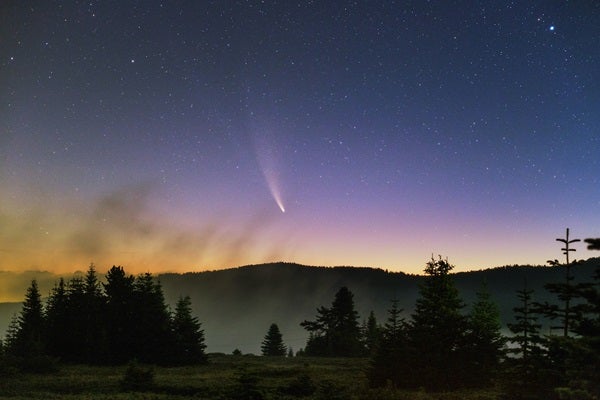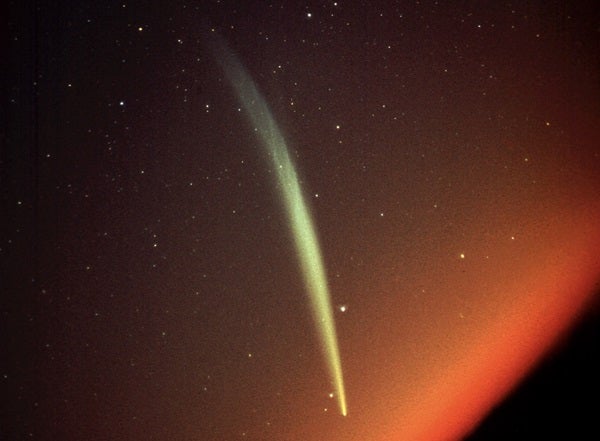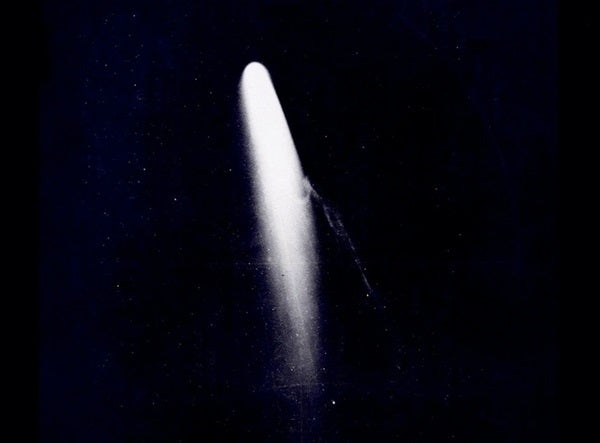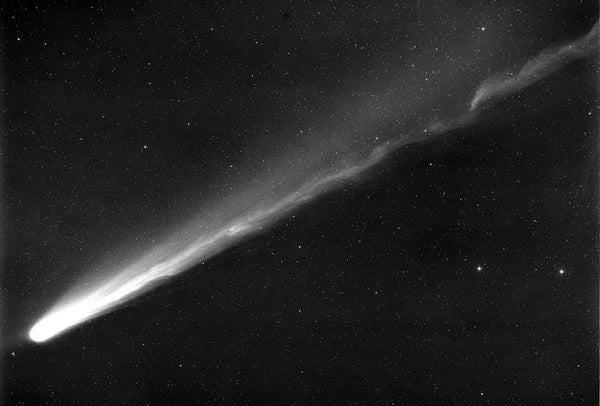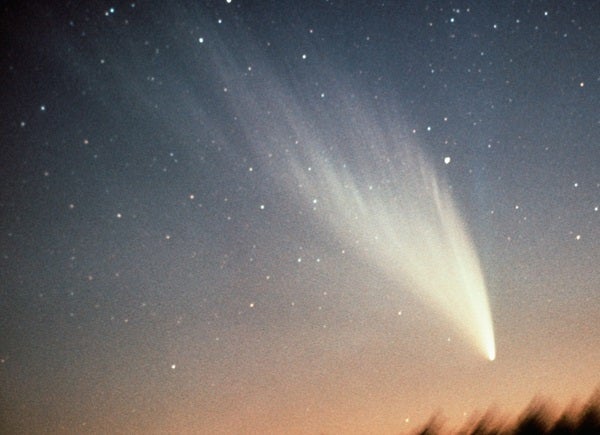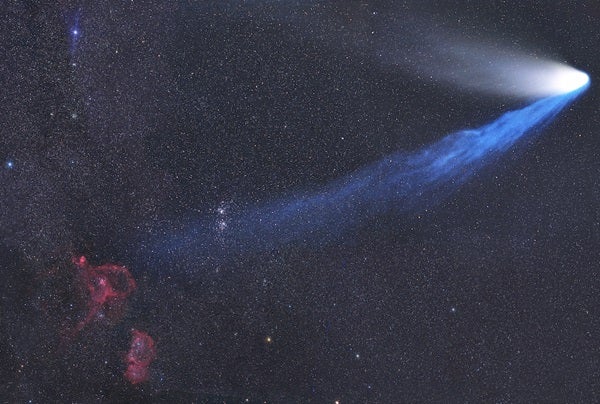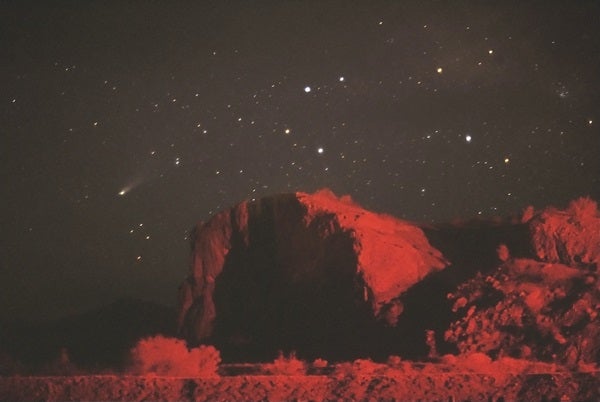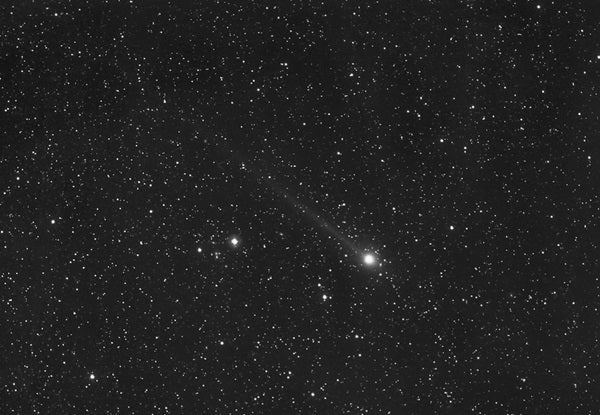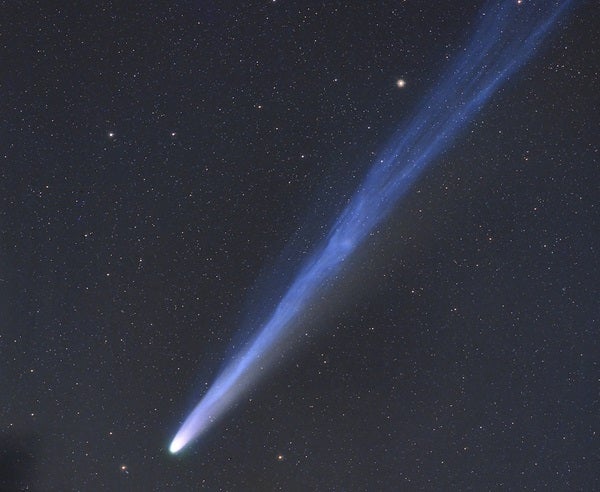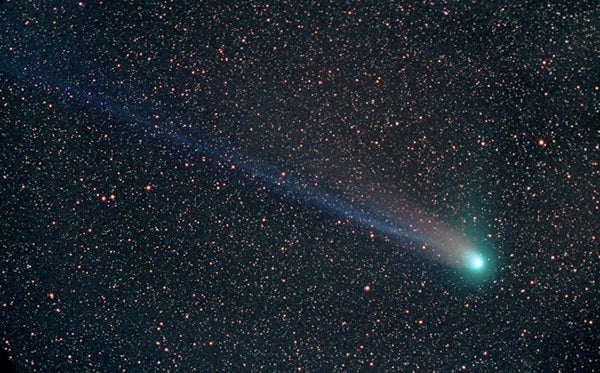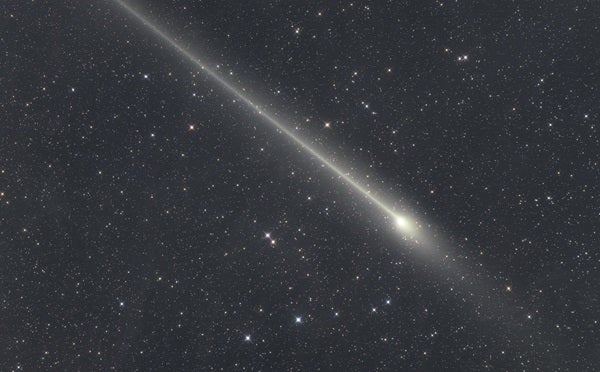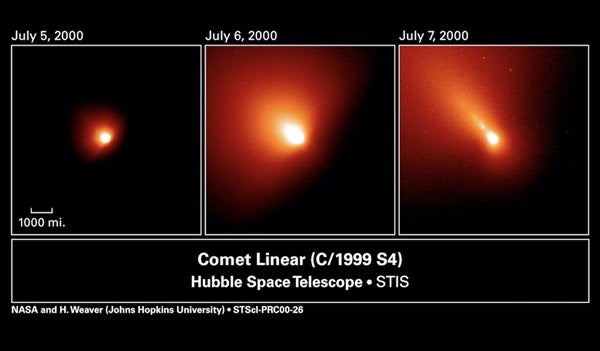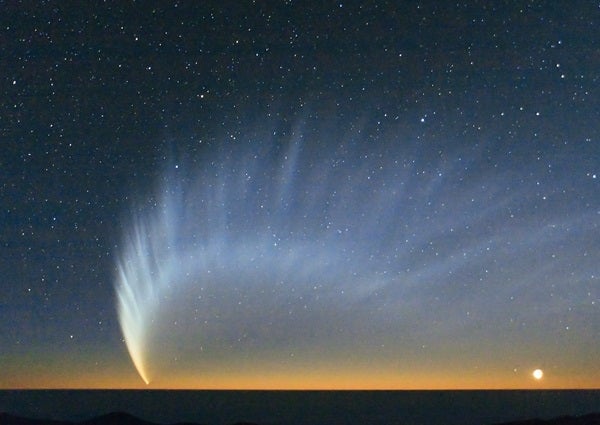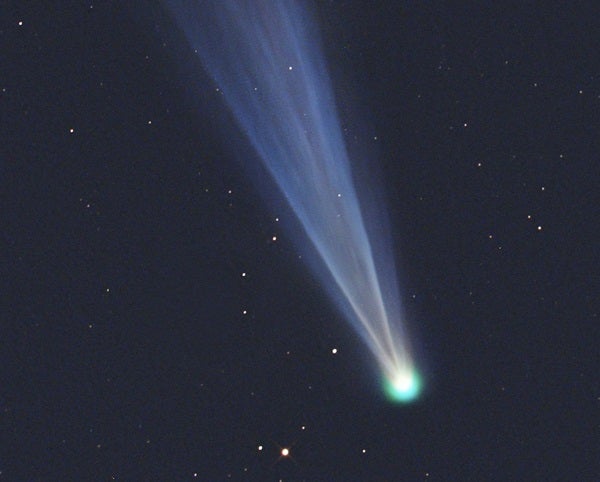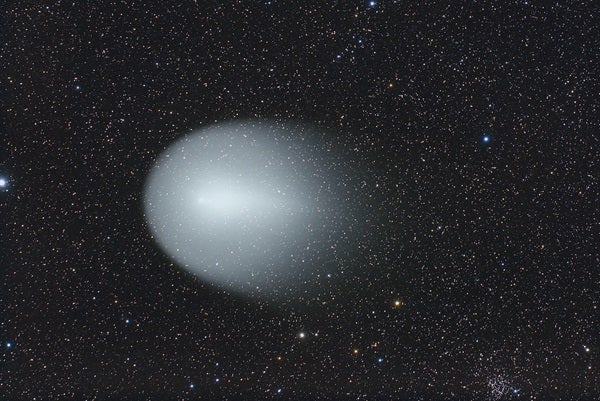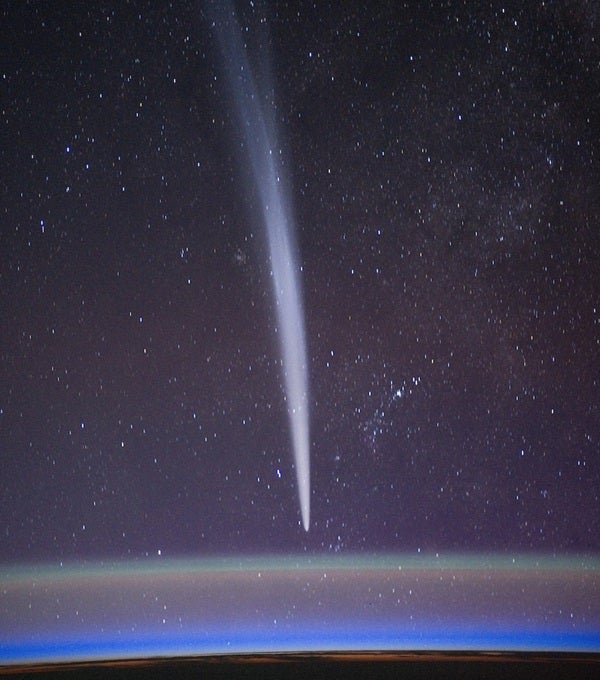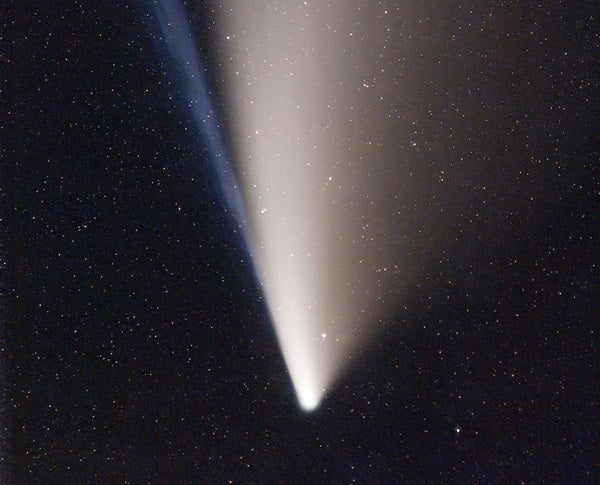Comets provide photographers with endless possibilities. They are dynamic close-up subjects: capable of shifting their form from night to night, sprouting nebulous comae, and even undergoing outbursts. Comets are also itinerant photobombers, regularly crossing paths with familiar deep-sky objects as they glide elliptically against the celestial sphere. And when great comets graze the Sun and unleash their tails across the entire sky, they make for spectacular wide-field vistas.
Where once these landscapes were captured only in sketches and paintings, the steady march of technology has enabled astroimagers to record them in increasingly stunning photographs. The images here capture some of the great (and nearly great) comets of the past six decades.
1. Ikeya-Seki (C/1965 S1)
Discovered in September 1965, this sungrazer lived up to all expectations. Over the next month, it blossomed into one of the brightest comets of the millennium — an indisputably great comet. This four-minute exposure was taken at dawn from Kitt Peak National Observatory Oct. 29, 1965, eight days after perihelion.
2. Bennett (C/1969 Y1)
Bennett’s ion tail featured a prominent kink, seen in this two-minute exposure taken April 4, 1970, with the 0.8-meter Schmidt telescope at Hamburg Observatory. Nine days later, the crew of Apollo 13 attempted to photograph Comet Bennett from deep space, but they were unsuccessful.
3. Kohoutek (C/1973 E1)
Comet Kohoutek may not have lived up to its billing as the “comet of the century,” but this three-minute exposure on Palomar Observatory’s 1.2-meter Schmidt telescope taken Jan. 12, 1974, captured its streaming tail in stunning detail.
4. West (C/1975 V1)
Burned by the letdown of Kohoutek, the media did not trumpet Comet West with much fanfare. But West put on a fine display and reached a peak apparent magnitude of –3, making it the brightest comet since Ikeya-Seki.
5. Hale-Bopp (C/1995 O1)
The magnificent Comet Hale-Bopp was already visible to the naked eye in May 1996, nearly a year before it reached perihelion. When it reappeared after swinging around the Sun, it remained visible unaided through nearly all of 1997. In this shot taken April 2, 1997, its blue ion tail is passing over the Heart and Soul nebulae (IC 1805 and IC 1848) at lower left and, just to the right, the Double Cluster in Perseus (NGC 869 and NGC 884).
6. Halley (1P)
Comet Halley’s most recent apparition, in 1986, was its least-favorable on record, especially for Northern Hemisphere viewers. Still, it was a nearly-once-in-a-lifetime chance to see the most famous comet in history. This photo captures one such moment from Lake Havasu, Arizona, in March of that year.
7. Levy (C/1990 K1)
Comet hunter David Levy is perhaps best known for his co-discovery of Shoemaker-Levy 9, which smashed into Jupiter in July 1994. But Comet Levy (C/1990 K1) put on a show closer to home, reaching magnitude 3.1 in August 1990. It was also the first comet observed by the Hubble Space Telescope.
8. Hyakutake (C/1996 B2)
As the world awaited the arrival of Hale-Bopp in early 1996, Comet Hyakutake, discovered Jan. 31, suddenly rose to prominence, temporarily stealing the spotlight with a colorful display. This five-minute exposure was taken as Hyakutake reached perihelion in April 1996.
9. NEAT (C/2002 V1)
Comet NEAT revealed a couple of intriguing scientific implications. To many astronomers’ surprise — and despite its apparent diminutive size — it survived its close encounter with the Sun. It even endured a solar storm in the form of a coronal mass ejection, a powerful cloud of charged particles ejected from the surface of the Sun. This plasma interacted with the tail, putting a kink in it.
10. PANSTARRS (C/2011 L4)
When this comet was discovered in June 2011 by the Pan-STARRS telescope on Haleakalā in Hawaii, it still lay between the orbits of Jupiter and Saturn. It finally became visible to the naked eye near perihelion in March 2013. Although it did not quite match initial brightness predictions, it featured a remarkably long anti-tail that spanned as much as 7°, visible in this May 22 image.
11. LINEAR (C/1999 S4)
Comet LINEAR was, overall, a bit of a disappointment, disintegrating before it reached perihelion in late July 2000. But before it fell apart, the Hubble Space Telescope managed to capture a dramatic outburst in early July, when the comet suddenly brightened by half in the span of four hours and, a day later, expelled a chunk of its crust behind it. These images offered scientists one of their most detailed glimpses to date of how a comet erupts and fragments.
12. McNaught (C/2006 P1)
Comet McNaught proved a treat for Southern Hemisphere observers, featuring prominent striations in its spectacular dust tail. The beautiful structure was captured fanning out above the Pacific Ocean in this image taken from Paranal Observatory in Chile in January 2007.
13. ISON (C/2012 S1)
Like so many comets before it, ISON was heralded and hyped but ultimately turned out to be a dud — relatively speaking. It still proved an alluring photographic target, as this shot from Nov. 21, 2013, demonstrates.
14. Holmes (17P)
Comet Holmes was discovered by Edwin Holmes in 1892 and has a period of just under seven years. But it was lost for several decades between 1906 and 1964 as it was too faint. It gave its most dazzling performance in October 2007, when it suddenly underwent an outburst. This image was taken Dec. 3, after the coma had expanded to a volume greater than that of the Sun.
15. Lovejoy (C/2011 W3)
Comet Lovejoy was discovered in November 2011 and emerged from perihelion in mid-December, putting a glimmering celestial bow on a festive time of year. Here, it appears above the limb of Earth Dec. 22, 2011, as photographed from the International Space Station by the orbiting laboratory’s then-commander Dan Burbank.
NEOWISE (C/2020 F3)
Comet NEOWISE was discovered in late March 2020, just as the world was locking down due to the COVID-19 pandemic. When it peaked July 23, it was the brightest comet since McNaught. Millions around the world went outside to observe it — socially distanced but reveling together in the sight of a sublime cosmic phantom. While astronomers debate whether NEOWISE qualifies as a great comet, we can all agree on one thing: Hopefully, the next great comet will arrive amid more auspicious circumstances.

